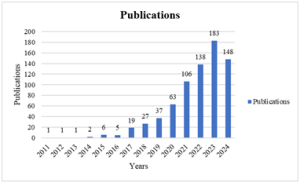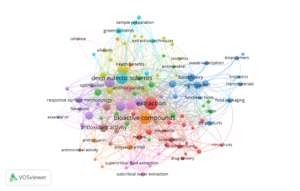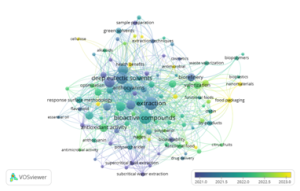A Bibliometric Analysis and Visualization of Research Trends in Green Extraction: A Novel Strategy for Anthocyanins Extraction Using Natural Deep Eutectic Solvents (NADES)
- Annisa Ul Karimah
- Fauzan Azima
- Tuty Anggraini
- 673-679
- Aug 9, 2024
- Food Science
A Bibliometric Analysis and Visualization of Research Trends in Green Extraction: A Novel Strategy for Anthocyanins Extraction Using Natural Deep Eutectic Solvents (NADES)
Annisa Ul Karimah, Fauzan Azima, and Tuty Anggraini*
Department of Agricultural Technology, Andalas University
*Corresponding Author
DOI: https://doi.org/10.51244/IJRSI.2024.1107051
Received: 24 June 2024; Accepted: 05 July 2024; Published: 09 August 2024
ABSTRACT
This article contributes to the bibliometric evaluation of the natural deep eutectic solvents and the study of the extraction of bioactive compounds, especially anthocyanins. Bibliometric analysis is the statistical analysis of published articles by researchers at a particular time and place, with the relation among these articles. The data were pre-processed and analyzed with the Vos Viewer and Bibliometrics, the professional mapping tools. 14 years of publication (from 2011 to 2024) were included in this evaluation process. VOS Viewer software has been used to classify the different keywords, according to their co-citation, following clustering techniques. Based on the results of a bibliometric analysis, from 2011 to 2024 have were 746 studies related to post-harvest extraction anthocyanins using natural deep eutectic solvents from ScienceDirect. From this study, it was found that research trends related to post-harvest natural deep eutectic solvents increased from 2011 until 2024. In this study, it was also found that the most natural deep eutectic solvents article publication titles in food chemistry. So natural deep eutectic solvents have a good impact on the use of solvents that can replace conventional organic solvents.
Keywords: Anthocyanin, Bibliometric, Natural Deep Eutectic Solvents, ScienceDirect, VOS viewer
INTRODUCTION
Extraction is the most important step in the recovery of bioactive compounds from natural products (Boateng, 2022). Traditionally, anthocyanin extraction involves the use of acidified polar solvents, such as water, methanol, ethanol, and acetonitrile (Alañón et al., 2020; Souza et al., 2020). While these solvents provide efficiency and stability for anthocyanin extraction, they have drawbacks such as high toxicity and cost, low extraction speed, and biodegradability, including environmental pollution (X.-J. Zhang et al., 2023). The challenges associated with conventional solvents contradict the principles of green chemistry, which has gained prominence in the agricultural food sector (Kim et al., 2024a; Mišan et al., 2020). Therefore, to meet both the industrial demand for natural ingredients and consumer environmental awareness, new technologies must be explored.
In 2003, Abbott et al. first proposed the concept of deep eutectic solvents (DES) and in 2011, Choi et al. proposed the concept of natural deep eutectic solvents (NADES). In general, NADES are mixtures consisting of a hydrogen-bond acceptor (HBA), such as a quaternary ammonium salt, e.g., choline chloride. Natural hydrogen-bond donors (HBD), such as an amino acid, a carboxylic acid, or a sugar (Cvjetko Bubalo et al., 2015). These mixtures of natural biocompatible compounds are characterized by intermolecular interactions, particularly hydrogen bonds, which confer excellent physicochemical properties to the NADES (Dai et al., 2013). NADES has the advantages of being green, nonflammable, highly biodegradable, easy to prepare, and inexpensive. In terms of extraction, NADES offer high efficiency and can facilitate the extraction of products varying widely in polarity.
Research in the articles on natural deep eutectic solvents is crucial for achieving green chemistry and food technology. This study presents a bibliometric analysis of extraction anthocyanins using natural deep eutectic solvents, which to the best of our knowledge, has never been conducted in the literature. The research aims to review the natural deep eutectic solvents and extraction of anthocyanins literature by providing a thorough bibliometric analysis to investigate the trend. The data based on the annual number of publications, most contributing authors, contributing subject discipline, thematic maps, gaps, and potential future study topics, countries and organizations with the largest contributions and their collaboration, include the literature that has citations (Mirawati et al., 2024). Additionally, this study aims to provide a comprehensive description of the current state of knowledge in the research of extraction of anthocyanins using natural deep eutectic solvents.
METHOD
Data Sources
In this study, we selected records taken from ScienceDirect as the data source. The selected research data use keywords, namely postharvest Natural Deep Eutectic Solvents Anthocyanins. The data taken in this bibliometric analysis starts from 2011 to 2024. The type of data taken is only in the form of research articles. Data is taken in RIS form and processed using Vos viewer.
Bibliometric Analysis
VOS viewer is a software tool for constructing and analyzing bibliometric networks from the scientific literature. VOS viewer creates networks based on co-authorship, co-citation, bibliographic coupling, or term co-occurrence, and visualizes them using the VOS algo rhythm that optimizes the correspondence between network distances and item similarities (Jiang et al., 2023). It also calculates various indicators to assess the centrality, business, novelty, and diversity of each cluster (Wang & Wang, 2022). The tools offer users flexibility in adjusting the parameters of network analysis and visualization.
This bibliometric study uses a VOS viewer (version 1.6.20) to visualize and analyze the final data taken from ScienceDirect. This research consists of three parts: an analysis of postharvest coffee publication trends, an analysis of journal publications, analysis of the number of journals published from 2011 to 2024. The bibliometric analysis chart depicts the relationship between two or more items with a link strength value indicating the level of relationship between items (M. Zhang et al., 2018).
RESULTS AND DISCUSSION
We collected the data through ScienceDirect, accessed on May 2024. Based on the data retrieval date, it is known that the latest publication was published in May 2024. Here we collected 777 articles that closely related to natural deep eutectic solvents and extraction of anthocyanins.
Bar Chart of Period Publishing
Figure 1. Bar Chart of Period Publishing
As shown in Fig 1, from 2011 to 2013, there was one research article published year. Then in 2014, increased to two articles. Then from 2015 until 2023, research articles increased significantly. In 2024, until May research articles already reach 148 articles. The highest number of research was published in 2023, with a total of 183 articles. The review articles were most commonly published in 2023 and 2024. The results of the bibliographical analysis are presented in Fig. 2 of this article. We present two visualizations filtered by keywords from the references: network visualization and overlay visualization.
Network Visualization Using Vos viewer
Figure 2. Network Visualization Using Vos viewer
Figure 2. presents the network visualization of the references, comprising 101 items, 10 clusters, 777 links, and a total link strength of 1297. The size of the circles and the distance between them reflect the number of citations and the level of similarity, respectively. Co-citation network analysis resulted in 5 distinct clusters depicted in 10 different colors: red, green, dark blue, yellow, purple, sky blue, orange, brown, pink, and peach where each color represents a research topic.
The largest cluster is extraction. Based on the visualization results obtained using Vos viewer, this visualization is divided into 10 clusters. The first cluster consists Cluster 1 (19 items) active packaging, antioxidant capacity, application, bioavailability, biological activity, citrus fruits, drug delivery, exraction, extraction methods, food industry, functional food, nades, natural products, pectin, polyphenol, purification, separation, stability, and toxicity. Cluster 2 (14 items) antimicrobial, antioxidant, bioaccessibility, bioactive compound, biological activities, chitin, chitosan, grape pomace, green solvent, natural deep eutectic solvent, phenolics, physicochemical properties, phytochemicals, and synthesis. Cluster 3 (14 items) antioxidants, bioethanol, bioplastics, biopolymers, biorefinery, by-products, carotenoids, encapsulation, food packaging, functional foods, nanomaterials, sustainability, valorization, and waste valorization. Cluster 4 (14 items) alkaloids, bioactives, biofuel, cosmetics, eutectic solvents, flavonoids, food, industrial applications, ionic liquid, medicinal plants, nutraceuticals, phytochemistry, polyphenols, and ultrasound.
Next, Cluster 5 (12 items) biomass, choline chloride, deep eutectic solvent, essential oil, flavonoid, green chemistry, microwave, natural deep eutectic solvents, optimization, phenolic compounds, response surface methodology, and ultrasonic-assisted extraction. Cluster 6 (7 items) aqueous two-phase system, deep eutectic solvents, extraction techniques, food analysis, green solvents, ionic liquids, and sample preparation. Cluster 7 (7 items) anthocyanin, bioactive compounds, food wastes, green analytical chemistry, health benefits, phenolic compound, and polysaccharides. Cluster 8 (6 items) antimicrobial activity, antioxidant activity, microwave-assisted extraction, natural deep eutectic solvents (nades), pressurized liquid extraction, ultrasound-assisted extraction. Cluster 9 (6 items) food by-products, green extraction, microalgae, nutraceutical, subcritical water extraction, and supercritical fluid extraction. Cluster 10 (2 items) anthocyanins and cellulose.
Overlay Visualization Using Vos viewer
Figure 3. Overlay Visualization Using Vos viewer
In Figure 3, the novelty of the articles is visually depicted, with brighter nodes indicating more recent publications. The yellow-colored nodes represent research and review articles published between 2022,5 and 2023, covering topics such as valorization, optimizing, and polyphenols. These recent articles reflect the latest advancements and investigations in the field of natural deep eutectic solvents.
On the other hand, the purple-colored nodes indicate articles published in older years, specifically from 2022 and earlier. These older publications might lay the foundation for the research on deep eutectic solvents but could be considered less current in terms of their relevance to the current state of knowledge. The green-colored nodes represent articles published in the intermediate period, around 2021 to 2021,5. These articles likely contributed to bridging the gap between earlier research and more recent findings.
From a close examination of Figure 3, we can infer that the majority of the research related to natural deep eutectic solvents primarily focuses on understanding their various components and their extraction. This suggests that researchers have been interested in exploring the biochemical constituents and potential applications of these components.
Furthermore, the visual representation in Figure 3 shows that some of these keywords have experienced significant development and processing, leading to the creation of green chemistry innovations. This shows that research on NADES has progresses beyond basic understanding and has entered the realm of applications and innovation in green chemistry. Below are several articles regarding the application of NADES from various natural sources in obtaining anthocyanins.
Table 1. Application of NADES from various natural sources in obtaining anthocyanins
| Natural Sources | Research purposes | Extracting solvent composition | Extraction method | Reference |
| Black chokeberry
(Aronia melanocarpa) |
The potential utility of UMAE-NADES in the food chmistry | Choline chloride : carboxylic acid
Choline chloride : sugar based |
Ultrasound-microwave-assisted extraction | (Lin et al., 2022) |
| Blackberry
(Rubus spp) |
Develop and establish a convenient, efficient for the extraction of anthocyanins from blackberry by using NADES-UAE | Choline chloride : sugar alcohol
Choline chloride : carboxylic acid Organic acid : sugar alcohol |
Ultrasound assisted extraction | (Zannou & Koca, 2022) |
| Blueberry | Optimize extraction method based on ternary NADES for blueberry anthocyanin | Choline chloride : organic acid : sugar alcohol | Ultrasound assisted extraction | (Silva et al., 2020) |
| Raspberry
(Rubus idaeus L.) |
Extraction conditions for the UAE-DES phenolic compounds and anthocyanins from raspberry fruits | Organic acid : sugar bades | Ultrasound assisted extraction | (Koraqi et al., 2023) |
| Thai pigmented rice bran | Environmentally friendly DES and UAE for recovery of antioxidant compounds from Thai pigmented rice bran | Choline chloride : carboxylic acid
Organic acid : sugar alcohol |
Ultrasound assisted extraction | (Ratanasongtham et al., 2024) |
| Brazilian berry
(Myrciaria cauliflora) |
Optimize the recovery of anthocyanin rich fractions from berry by product using DES-PLE | Choline chloride : propylene glycol
Choline chloride : malic acid |
Pressurized liquid extraction | (Benvenutti et al., 2022) |
| Korean black raspberries
(Rubus coreanus Miquel) |
Environmentally friendly method for extract anthocyanins from Korean black raspberries using a NADES via UAE | Choline chloride : carboxylic acid
|
Ultrasound assisted extraction | (Kim et al., 2024) |
| Blueberry leaves | Develop a novel UAE method for the extraction of phenolic compounds from blueberry leaves using NADES | Choline chloride : sugar based
Choline chloride : sugar alcohol Betaine : organic acid Proline : organic acid |
Ultrasound assisted extraction | (Santos-Martín et al., 2023) |
| Vitis davidii Foex. | Effective and green alternative extraction method for the food sector | Choline chloride : carboxylic acid
|
Ultrasound assisted extraction | (S. Zhang et al., 2024) |
CONCLUSION
In this study, we present the use of data from ScienceDirect for bibliometric analysis. This study aims to find out the trend of post-harvest research on natural deep eutectic solvents from 2011 to 2024. From the results of the study, it was found that, for post-harvest research on natural deep eutectic solvents, there is an increase in the Vos Viewer visualization form. In this study, it was also found that the title of the articles published a lot of articles related to natural deep eutectic solvents and extraction of anthocyanins as food chemistry.
REFERENCES
- Abbott, A. P., Capper, G., Davies, D. L., Rasheed, R. K., & Tambyrajah, V. (2003). Novel solvent properties of choline chloride/urea mixtures. Chemical Communications, 1, 70–71.
- Alañón, M. E., Ivanović, M., Pimentel-Mora, S., Borrás-Linares, I., Arráez-Román, D., & Segura-Carretero, A. (2020). A novel sustainable approach for the extraction of value-added compounds from Hibiscus sabdariffa L. calyces by natural deep eutectic solvents. Food Research International, 137, 109646. https://doi.org/https://doi.org/10.1016/j.foodres.2020.109646
- Benvenutti, L., Zielinski, A. A. F., & Ferreira, S. R. S. (2022). Pressurized aqueous solutions of deep eutectic solvent (DES): A green emergent extraction of anthocyanins from a Brazilian berry processing by-product. Food Chemistry: X, 13, 100236. https://doi.org/https://doi.org/10.1016/j.fochx.2022.100236
- Boateng, I. D. (2022). A Critical Review of Emerging Hydrophobic Deep Eutectic Solvents’ Applications in Food Chemistry: Trends and Opportunities. Journal of Agricultural and Food Chemistry, 70(38), 11860–11879. https://doi.org/10.1021/acs.jafc.2c05079
- Choi, Y. H., van Spronsen, J., Dai, Y., Verberne, M., Hollmann, F., Arends, I. W. C. E., Witkamp, G.-J., & Verpoorte, R. (2011). Are natural deep eutectic solvents the missing link in understanding cellular metabolism and physiology? Plant Physiology, 156(4), 1701–1705.
- Cvjetko Bubalo, M., Vidović, S., Radojčić Redovniković, I., & Jokić, S. (2015). Green solvents for green technologies. Journal of Chemical Technology & Biotechnology, 90(9), 1631–1639.
- Dai, Y., Van Spronsen, J., Witkamp, G.-J., Verpoorte, R., & Choi, Y. H. (2013). Natural deep eutectic solvents as new potential media for green technology. Analytica Chimica Acta, 766, 61–68.
- Jiang, H., Chen, H., Duan, Z., Huang, Z., & Wei, K. (2023). Research progress and trends of biochar in the field of wastewater treatment by electrochemical advanced oxidation processes (EAOPs): A bibliometric analysis. Journal of Hazardous Materials Advances, 100305.
- Kim, H., Jung, Y. S., Song, N.-E., Yoo, M., Seo, D.-H., Kim, H.-S., & Nam, T. G. (2024a). Ultrasound-assisted extraction of major anthocyanins in Korean black raspberries (Rubus coreanus Miquel) using natural deep eutectic solvents. LWT, 199, 116121. https://doi.org/https://doi.org/10.1016/j.lwt.2024.116121
- Kim, H., Jung, Y. S., Song, N.-E., Yoo, M., Seo, D.-H., Kim, H.-S., & Nam, T. G. (2024b). Ultrasound-assisted extraction of major anthocyanins in Korean black raspberries (Rubus coreanus Miquel) using natural deep eutectic solvents. LWT, 199, 116121. https://doi.org/https://doi.org/10.1016/j.lwt.2024.116121
- Koraqi, H., Trajkovska Petkoska, A., Khalid, W., Kumar, N., & Pareek, S. (2023). Optimization of experimental conditions for bioactive compounds recovery from raspberry fruits (Rubus idaeus L.) by using combinations of ultrasound-assisted extraction and deep eutectic solvents. Applied Food Research, 3(2), 100346. https://doi.org/https://doi.org/10.1016/j.afres.2023.100346
- Lin, S., Meng, X., Tan, C., Tong, Y., Wan, M., Wang, M., Zhao, Y., Deng, H., Kong, Y., & Ma, Y. (2022). Composition and antioxidant activity of anthocyanins from Aronia melanocarpa extracted using an ultrasonic-microwave-assisted natural deep eutectic solvent extraction method. Ultrasonics Sonochemistry, 89, 106102. https://doi.org/https://doi.org/10.1016/j.ultsonch.2022.106102
- Mirawati, D. K., Wiyono, N., Ilyas, M. F., Putra, S. E., & Hafizhan, M. (2024). Research productivity in catamenial epilepsy: A bibliometric analysis of worldwide scientific literature (1956-2022). Heliyon, e31474. https://doi.org/https://doi.org/10.1016/j.heliyon.2024.e31474
- Mišan, A., Nađpal, J., Stupar, A., Pojić, M., Mandić, A., Verpoorte, R., & Choi, Y. H. (2020). The perspectives of natural deep eutectic solvents in agri-food sector. Critical Reviews in Food Science and Nutrition, 60(15), 2564–2592. https://doi.org/10.1080/10408398.2019.1650717
- Ratanasongtham, P., Bunmusik, W., Luangkamin, S., Mahatheeranont, S., & Suttiarporn, P. (2024). Optimizing green approach to enhanced antioxidants from Thai pigmented rice bran using deep eutectic solvent-based ultrasonic-assisted extraction. Heliyon, 10(1), e23525. https://doi.org/https://doi.org/10.1016/j.heliyon.2023.e23525
- Santos-Martín, M., Cubero-Cardoso, J., González-Domínguez, R., Cortés-Triviño, E., Sayago, A., Urbano, J., & Fernández-Recamales, Á. (2023). Ultrasound-assisted extraction of phenolic compounds from blueberry leaves using natural deep eutectic solvents (NADES) for the valorization of agrifood wastes. Biomass and Bioenergy, 175, 106882. https://doi.org/https://doi.org/10.1016/j.biombioe.2023.106882
- Silva, D. T. da, Pauletto, R., Cavalheiro, S. da S., Bochi, V. C., Rodrigues, E., Weber, J., Silva, C. de B. da, Morisso, F. D. P., Barcia, M. T., & Emanuelli, T. (2020). Natural deep eutectic solvents as a biocompatible tool for the extraction of blueberry anthocyanins. Journal of Food Composition and Analysis, 89, 103470. https://doi.org/https://doi.org/10.1016/j.jfca.2020.103470
- Souza, H. K. S., Mateus, N., de Freitas, V., Gonçalves, M. P., & Cruz, L. (2020). Chemical/Color Stability and Rheological Properties of Cyanidin-3-Glucoside in Deep Eutectic Solvents as a Gateway to Design Task-Specific Bioactive Compounds. ACS Sustainable Chemistry & Engineering, 8(43), 16184–16196. https://doi.org/10.1021/acssuschemeng.0c04839
- Wang, W., & Wang, Z. (2022). Retrospecting the researches and efforts on Lancang-Mekong water issues: a bibliometric perspective. Water Policy, 24(12), 1930–1950. https://doi.org/10.2166/wp.2022.170
- Zannou, O., & Koca, I. (2022). Greener extraction of anthocyanins and antioxidant activity from blackberry (Rubus spp) using natural deep eutectic solvents. LWT, 158, 113184. https://doi.org/https://doi.org/10.1016/j.lwt.2022.113184
- Zhang, M., Gao, M., Yue, S., Zheng, T., Gao, Z., Ma, X., & Wang, Q. (2018). Global trends and future prospects of food waste research: a bibliometric analysis. Environmental Science and Pollution Research, 25(25), 24600–24610. https://doi.org/10.1007/s11356-018-2598-6
- Zhang, S., Lin, S., Zhang, J., & Liu, W. (2024). Ultrasound-assisted natural deep eutectic solvent extraction of anthocyanin from <em>Vitis davidii</em> Foex. pomace: Optimization, identification, antioxidant activity and stability. Heliyon, 10(12). https://doi.org/10.1016/j.heliyon.2024.e33066
- Zhang, X.-J., Liu, Z.-T., Chen, X.-Q., Zhang, T.-T., & Zhang, Y. (2023). Deep eutectic solvent combined with ultrasound technology: A promising integrated extraction strategy for anthocyanins and polyphenols from blueberry pomace. Food Chemistry, 422, 136224. https://doi.org/https://doi.org/10.1016/j.foodchem.2023.136224



